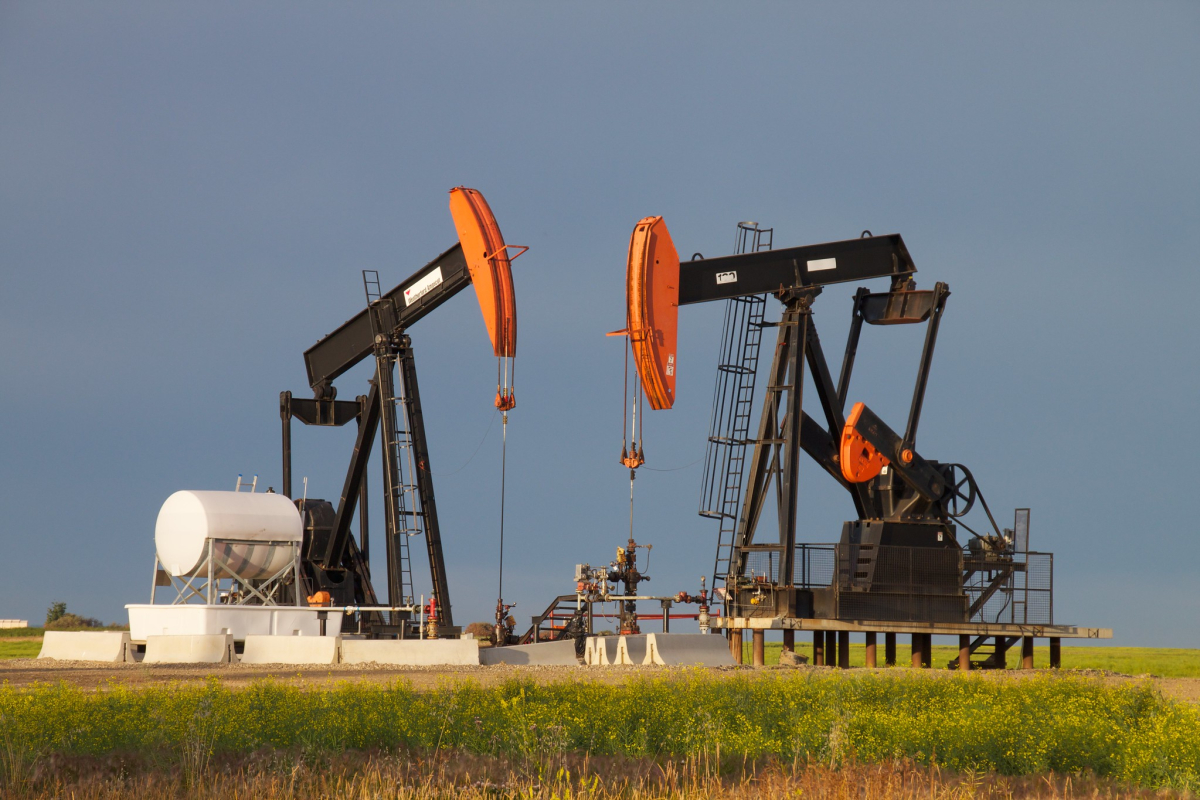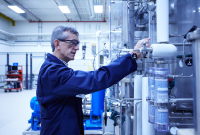Thank you for helping us meet our fundraising goal!
On the same day Keystone XL was officially axed, Alberta’s oil and gas industry made two massive bets on carbon capture, representing billions of dollars, designed to extend the life of the oilsands indefinitely.
One bet is on blue hydrogen. Air Products Canada, a subsidiary of its Pennsylvania-headquartered parent company, announced it was moving ahead on a $1.3-billion carbon capture and hydrogen production complex in Edmonton. That facility would aim to capture 95 per cent of carbon from natural gas used in the production of hydrogen-fuelled electricity and liquified hydrogen. It’s expected to be operating by 2024.
Both Ottawa and Alberta have signed a memorandum of understanding to potentially invest in expanding the company’s hydrogen network.
The second bet was a joint announcement from oilsands majors Suncor Energy, Cenovus Energy, Canadian Natural Resources, MEG Energy, and Imperial that they’ve formed an “alliance” to reach net-zero emissions. The companies, which are responsible for about 90 per cent of production in the tar sands, intend to reach this goal through a carbon capture, utilization and storage scheme similar to Norway’s multibillion-dollar Longship project.
Critically, the project “will require significant investment on the part of both industry and government to advance the research and development of new and emerging technologies,” according to the oil companies’ joint press release, signalling the plan is a gamble on technology not yet available.
“The oil and gas industry loves to say they're not subsidized, and then continuously calls for more government support,” said Julia Levin, senior program manager for climate and energy at advocacy group Environmental Defence. “But in this context, we have choices to be making; we don't have unlimited public or private capital to be investing in the energy transition.
“We can decide to go big on the things we know work and we know will bring the majority of the deep emissions (cuts) needed — ramping up renewables, ramping up energy efficiency, and putting a lot of government funding in those — or we can take an extremely risky strategy that serves only the interests of the oil and gas sector,” she said.
The “net-zero” plan would require a trunkline connecting Fort McMurray and Cold Lake oilsands operations to a site near Cold Lake that the companies say could be connected to the Edmonton region, hinting at the city’s emerging role as a blue hydrogen hub.
“It's clear the energy transition is happening, so this industry is figuring out how can we get every barrel that we can out of the ground, and the way they've come up to do that is blue hydrogen; a completely unhelpful technology that’s only purpose is to create another revenue stream for natural gas,” said Levin.
Hydrogen is colour-coded, with grey meaning produced from natural gas, blue meaning produced from natural gas with carbon capture technology used, and green meaning produced using renewable electricity.
Pembina Institute deputy executive director Simon Dyer said if the oilsands sector is serious about decarbonizing, it will need massive amounts of investment, but it also needs to set some short-term milestones.
“It's obviously very fashionable to commit to net-zero now, but there needs to be a commitment that the oil and gas industry intends to contribute to Canada meeting its 2030 targets under (the Paris Agreement),” he said.
Canada’s target is to curb greenhouse gas emissions by 40 per cent from 2005 levels, requiring a 39 per cent drop to happen in the next nine years. Dyer said Ottawa has committed to net-zero, many companies have committed to net-zero, but the government of Alberta is “very absent from this conversation.”
“(The Alberta government) doesn't have a climate plan,” he said. “They have no emissions reduction targets for Alberta at all, either by 2030 or 2050, and you could actually say the lack of a clear-cut climate plan, and a commitment to net-zero in Alberta, is the biggest limiting factor to seeing the climate investments we need in decarbonization.”
That’s because next to profitability, predictability is high on an investor’s list of priorities. And Dyer says that provinces fighting the federal carbon tax, or threatening to roll back other policies, creates a climate that disincentivizes the types of investments needed.
Keystone XL’s death Dyer called a “risky bet with taxpayer dollars,” one that has now left a $1.3-billion hole in Alberta’s coffers.
“Governments need to be very cautious and wary of making subsidies to incumbent industries that maybe are not on a growth trajectory compared to where the economy is going,” he said.
Dyer added markets are changing “very fast” because investors are looking for climate action, leaving oilsands companies at “an existential point.” He said from the Pembina Institute’s perspective, an announcement this week on a plan to reach net-zero is too late.
“Pembina wrote a report in 2006 saying if the oilsands wanted to be able to compete, it needed to be carbon-neutral or net-zero, and that was 15 years ago,” he said.
The major oilsands producers who’ve pledged net-zero tout their contributions to Canada’s GDP at about $100 billion a year, citing that as one reason to preserve the industry with carbon capture technologies. But even as oilsands producers post record production figures, since 2000, royalty revenue is down 45 per cent, and tax revenues from the oil and gas sector have fallen from over 14 per cent in 2009 to less than four per cent in 2018 of all industry taxes. These cuts represent billions of dollars of lost revenue for the public purse.
When Levin hears unproven claims like the oil and gas sector will keep $3 trillion over the next 30 years in Canada’s GDP by implementing carbon capture, she says that’s a bet on climate failure.
“The IEA (International Energy Agency) in their recent net-zero report was very clear that we have to ramp down the production and use of oil and gas from four-fifths to less than one-fifth,” she said. “And that will only come from select countries, and Canada won’t be one of those because our oil and gas is more expensive and more environmentally destructive.”
John Woodside / Local Journalism Initiative / Canada's National Observer






Comments
So this natural gas will be burned to make electricity, at a higher cost than wind power now makes electricity. The resulting CO2 will be captured, adding more cost and making the electricity still more expensive. Then the CO2 will be piped to the tar sands to boost bitumen production, and maybe some natural gas liquids will be used to make more dilbit, at a far higher cost than the Saudis produce crude.
The dilbit will be exported, refined and burned, producing still more CO2 that will not be captured, or taxed. (And if it is taxed, someone else - not Canada - will collect the money.)
It looks like a scheme for burning our money and heating the planet. Where is the logic?
"Alberta is gambling its future on carbon capture"
Alberta is gambling OUR future and OUR tax dollars on carbon capture. To protect the profits of the fossil fuel industry. Not in the public interest.
*
Article: "Pembina Institute deputy executive director Simon Dyer said if the oilsands sector is serious about decarbonizing, it will need massive amounts of investment, but it also needs to set some short-term milestones."
Even if upstream emissions (from extraction activities) are reduced to zero, this does nothing to offset or reduce downstream emissions at the consumer end. The oil industry has no plans to decarbonize the downstream combustion of fossil fuels, where 80% of the emissions from a barrel of oil occur.
The Pembina Institute — largely funded by big oil companies, the Big Banks, and corporate Canada — has long promoted the oxymoron of "responsible oilsands development." If Pembina wants to stay relevant in the climate conversation, it needs to get off the fence.
"The IEA concluded that the Paris Agreement goal to limit global warming to 1.5 C demands a 75% reduction in oil consumption by 2050, with no investments in new fossil fuel supply starting today." If Pembina won't get with the program, maybe it's time to switch the channel.
"The major oilsands producers who’ve pledged net-zero tout their contributions to Canada’s GDP at about $100 billion a year, citing that as one reason to preserve the industry with carbon capture technologies."
In 2019 Canada's energy sector DIRECTLY contributed 7.2% to GDP. Including oil & gas, nuclear, hydro, coal, and renewables. Petroleum accounted for 5.3%. Crude oil accounted for 2.8%. The oilsands sector represents a fraction of that. (NRCan)
https://www.nrcan.gc.ca/science-data/data-analysis/energy-data-analysis…
Subtract (astronomical) externalized environmental, climate change, and health costs — and subsidies. AB's oil & gas industry has barely started to fund its clean-up liabilities: north of $260 billion.
How much are the fossil fuel industry's profits costing us?
They're costing us more than we'll ever be able to repay......its our arable land and potable water that will be the real losers.
To answer the question in this article's by-line: Will this blue hydrogen/carbon capture scheme pay off?
NO....IT WILL DELAY REAL TRANSITION, SUCK MONEY FROM RENEWABLES AND GREEN HYDROGEN THAT WILL WORK, AND ENRICH THE OFF SHORE ACCOUNTS OF A FEW SLY DOGS WHO, AFTER DECADES OF DENYING GLOBAL WARMING AND THEIR PART IN IT...NOW ARE DRESSING THEMSELVES UP FOR THE PARTY CALLED GREEN WASH.
Sadly, the Alberta public is too addicted to oil to wake up to the SHELL game...so more Alberta impoverishment is likely baked in.
Largely agreed, except the reference to green hydrogen. I mean, it's not like green hydrogen wouldn't WORK, exactly, it's just a lousy solution compared to straight electricity and batteries, one which basically nobody would be talking about if it weren't for the oil sector suddenly being into the grey/blue kind of hydrogen. And indeed, despite early research, and in BC the brief prominence of Ballard powersystems and their hydrogen power cells, hydrogen had faded because it couldn't compete with battery electric. So nobody WAS talking about it, and if we can get the oil companies to shut up nobody will be talking about it again.
"Given their inherent advantages such as availability, competitiveness and ease of transport, fossil fuels, which account for 80% of Canada’s primary energy demand (96% in Alberta and Saskatchewan-see Figure 1), are expected to remain a major component of Canada’s energy supply in the near future (CEO, 1999)."
This quote comes from a paper that surveys CO2 capture technology in Canada. https://citeseerx.ist.psu.edu/viewdoc/download?doi=10.1.1.210.5488&rep=…
Ignoring for a moment the social and economic effects of shutting down Canada's oil and gas industry, can we not agree that putting money into carbon capture research and development could lead to technologies that could actually reduce atmospheric CO2 levels to pre-industrial levels, and that this would be a 'good thing'?
Carbon removal technologies can be researched and developing without pouring billions of tax dollars into carbon capture to keep the fossil fuel industry on life support. Those billions of dollars can be spent on actual climate solutions that reduce fossil fuel emissions, most of which occur at the consumer end. An ounce of prevention…
The idea is not to "shut down" Canada's energy industry but to transform it. Build back better.
*
Alberta's oil industry is at the mercy of global oil markets. AB gets hammered every time the oil price crashes. Massive job losses. Huge holes in AB's budget and loss of services.
The road to prosperity does not lie in exporting increasing volumes of commodities that the world wants less and less of. Export goods and services that the world wants more of.
Building fossil fuel assets to be stranded within decades is folly. Doubling down on fossil fuels sets us up for massive economic dislocation: oil price crashes and job losses.
Leaving our fate to global oil markets is folly. Get off the fossil fuel rollercoaster. Start building our sustainable future now — not decades from now.
The world is changing. Either we change with it or get left behind.
"I skate to where the puck is going to be, not where it has been." (Gretzky)
I totally agree with your assessment. There are already promising CO2 capture technologies being developed in Europe in particular Iceland. We don't have to give in to promises from O&G and we don't have to give in to 'guilt trips' from the Alberta government either.
Given its inherent market price advantage of $34 / MT (recent auctions), Alberta's current wind power industry outcompetes all other forms of fossil fuels in the generation of electricity. This leads to the generation of more overall renewable power, which will enable the Alberta economy to electrify and meet new demand curves, especially the ramping up of electric vehicles. This in turn displaces the primary market for bitumen both domestically and internationally (EVs are an emerging worldwide phenomenon).
It doesn't matter how many jobs Alberta fossil fuels provide (not as many as proponents like to imply, especially when compared to other employment sectors), they are still subject to supply and demand. Last century oil trends are downward sloped over the course of this century as electricity from renewables gain traction and climate action becomes international law. Cheaper renewables, the advent of the displacement of combustion engines with electric motors and the outstanding invoice for cleaning up its environmental mess leaves Alberta oil with an enormous problem that no amount of hydrogen dreaming can assuage.
Long story short, it's cheaper and easier to float renewables and human resources (knowledge, tech ...) over natural resources as beneficial economic solutions apropos to our mounting challenges.
So...if the World is committed to reducing emissions by 100% in the next 30 years how can demand for fossil fuels not continue to go down dramatically like it has been doing? Plus, if carbon capture was a viable option we would have done it 60 years ago...it’s not and will never be able to compete with renewables that continue to get cheaper and cheaper! Delaying was like denying, nothing changes, except that things keep get hotter and hotter, and that heat is taking all the fun out of life and leaving the sixth extinction in its place! Humanity needs to grow up while we still can!
The technology of removing carbon from the atmosphere at large is very different from the technology of removing carbon from the smokestacks from giant fires. Vastly different concentration levels involved, and significantly different objectives. That is, the point of CCS is to take all the carbon out of a small area, letting as little as possible past. The objective of atmospheric carbon renewal is to maximize overall removal over a larger space, while minimizing price per tonne removed--whether you remove all the carbon at once in any given volume of air isn't important. I don't think developing the latter really "leads to" the former, although there are probably some points in common. If you want to develop atmospheric carbon removal technologies, you should fund that directly.
Come to that, the best available technology for taking carbon out of the atmosphere is amazingly well developed and self-replicating; it's called "plants".
It all sounds good but the devil's in the details and this article pretty much puts to bed the O&G and Alberta's support of these kind of programs. The federal government is going to be taking a lot of heat from Alberta to put more taxpayer money into these programs at the cost of green renewable energies.